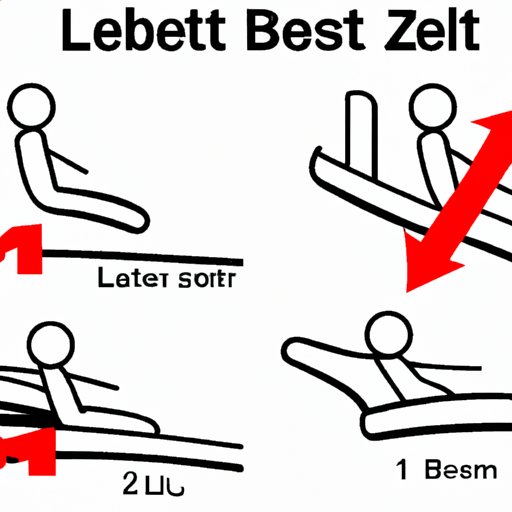
Introduction
When it comes to the safety of our children, there’s no such thing as being too cautious. Yet, every year, thousands of children are injured in car accidents. In fact, car crashes are one of the leading causes of death and injury for children under age 13. One way to minimize the risks is by using a booster seat to keep children secure during car rides. But what is the weight for a booster seat? Understanding weight limits is crucial to ensuring the safety of our little ones while on the road.
The Importance of Understanding the Weight Limits for Booster Seats
Booster seats are designed to provide additional support to a child who has outgrown a regular car seat but is still too small to use an adult seat belt. Weight limits are important because they indicate the range of weight at which a booster seat is most effective. Too little weight and the booster seat may not provide enough support, and too much weight can cause the seat to fail or become unsafe.
Not following weight limit guidelines can have severe consequences, such as an increased risk of injury or even death. It’s important to remember that booster seats are not one size fits all. Proper use of booster seats can reduce the risk of serious injury by 45 percent for children aged four to eight years, according to the National Highway Traffic Safety Administration (NHTSA).
Maximizing Safety: How Booster Seat Weight Limits Keep Children Secure
Booster seats work by elevating a child so that the seat belt fits properly across their lap and shoulder. Weight limits play a crucial role in determining how effective the booster seat is at this task. The weight limits are typically indicated on the booster seat itself or in the manufacturer’s guidelines.
Age and height guidelines are also important to consider, as they affect how the child sits in the booster seat. However, weight limits are the most reliable indicator of when a child has outgrown their booster seat and is ready to use a regular seat belt.
Breaking Down Booster Seat Weight Limits: What You Need to Know
Booster seats can have several different weight limits that parents need to be aware of. These include minimum weight, maximum weight, and weight ranges. The minimum weight limit is the weight at which a child can be safely secured in a booster seat. The maximum weight limit is the amount of weight that a booster seat can safely support. Sometimes booster seats have a range of weight limits, meaning they can support a certain weight range. Parents should check the manufacturer guidelines to ensure they’re using the booster seat within the appropriate weight range.
Below are examples of popular booster seats and their weight limit guidelines:
– Graco Tranzitions 3-in-1 Harness Booster: 22-100 lbs.
– Chicco MyFit Harness + Booster: 25-65 lbs. (harness mode) and 40-100 lbs. (booster mode)
– Evenflo Big Kid High-Back Booster Car Seat: 30-110 lbs.

Beyond Age and Height: Why Weight Matters in Booster Seat Safety
Weight is a crucial factor in determining a child’s overall safety in a booster seat. Children experience sudden growth spurts and weight changes, and it’s important to monitor this regularly and adjust the booster seat accordingly. A child who has outgrown their booster seat can become injured in an accident because the seat belt isn’t properly positioned across their body.
It’s important to emphasize that parents should check their child’s weight regularly and adjust the booster seat according to the weight limits set by the manufacturer.
Navigating the Confusing World of Booster Seats: Understanding Weight Limits
The world of booster seats can be confusing, with different types of seats, various weight limits, and a variety of guidelines to follow. Educating oneself on this topic is crucial for parents and caregivers to ensure their children are safe while in a vehicle.
Some common misconceptions around booster seat weight limits include thinking that age alone determines when a child should move to a booster seat or thinking that using a higher weight limit booster seat is always safer. However, the correct use of a booster seat according to weight is what ultimately ensures safety.
There are resources available to help parents better understand the ins and outs of booster seats, such as the NHTSA’s website, which provides in-depth information on booster seat safety.
The Surprising Truth About Booster Seat Weight Limits and Child Safety
Booster seat weight limits play a crucial role in keeping children safe while in a vehicle. For example, research shows that 15 percent of children between the ages of four and eight still use a regular seat belt, even though they are not big enough to do so safely. This is why more states are adopting laws that require children to be in a booster seat until they reach a certain minimum height and weight.
It’s also important to remember that using a booster seat isn’t just about following the law; it’s about ensuring the safety of our children. Booster seats can work to prevent serious injury and even save lives.
Avoiding Common Mistakes: How to Choose the Right Booster Seat Based on Weight Limits
Choosing the correct booster seat for a child’s weight is crucial for their safety while in a vehicle. When selecting a booster seat, it’s essential to keep the manufacturer’s weight limit guidelines in mind.
Some practical advice for parents and caregivers includes reading the manufacturer’s guidelines carefully, choosing a booster seat with weight limits that match the child’s weight, and consulting with a certified car seat technician if there are any questions or concerns.
Conclusion
Booster seat weight limits play a key role in keeping our children safe while in a vehicle. Understanding and following weight limit guidelines is essential for parents and caregivers to ensure that our little ones are secure and protected during car rides.
Remember to check the manufacturer’s guidelines for the appropriate weight range and consistently monitor a child’s weight to ensure they are still within the acceptable range for the booster seat they are using. By taking the necessary steps, we can ensure that our children are protected and safe every time they get in a vehicle.





